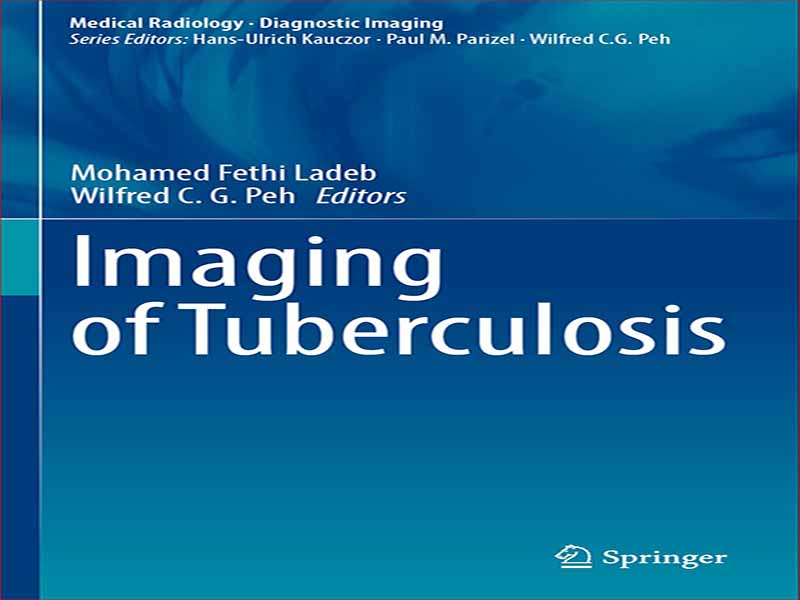- عنوان کتاب: Imaging of Tuberculosis
- نویسنده: Hans-Ulrich Kauczor
- حوزه: تصویربرداری تشخیصی
- سال انتشار: 2022
- تعداد صفحه: 131
- زبان اصلی: انگلیسی
- نوع فایل: pdf
- حجم فایل: 45.1 مگابایت
سل با وجود سرمایه گذاری قابل توجه در خدمات مراقبت های بهداشتی در چند دهه اخیر، یک نگرانی جهانی برای سلامتی باقی مانده است. با توجه به اینکه سالانه حدود ده میلیون نفر به سل مبتلا می شوند و بیش از 1.3 میلیون نفر بر اثر این بیماری جان خود را از دست می دهند، تأثیر سل در سراسر جهان بسیار مهم است. ویژگی های بالینی سل می تواند غیر اختصاصی باشد و اغلب به صورت موذیانه رخ می دهد. تصویربرداری نقش مهمی در تشخیص زودهنگام آن، به ویژه در بیمارانی که با علائم غیراختصاصی مراجعه می کنند، دارد. به تشخیص بیماری، هدایت تحقیقات آزمایشگاهی مناسب، تایید تشخیص، و نظارت بر پیشرفت بیماری و پاسخ به درمان، با هدف دستیابی به نتیجه درمانی موثر و پیشگیری از عوارض کمک می کند.
رادیوگرافی یک ابزار غربالگری عالی است و معمولاً بررسی اولیه رادیولوژیک برای مشکوک به سل ریوی و اسکلتی عضلانی است. توموگرافی کامپیوتری (CT) برای ارزیابی بیشتر سل ریوی، شکم، ادراری تناسلی و سر و گردن استفاده می شود. تصویربرداری رزونانس مغناطیسی روش انتخابی برای ارزیابی سل مغز، ستون فقرات و سیستم اسکلتی عضلانی است. توموگرافی با انتشار پوزیترون/CT نقش تدریجی فزاینده ای در تشخیص ضایعات سل چند کانونی و ارزیابی پاسخ به درمان دارد. تکنیک های تصویربرداری مانند اولتراسوند و سی تی برای هدایت آسپیراسیون ها و زهکشی های تشخیصی و درمانی و همچنین بیوپسی برای تایید هیستوپاتولوژیک و باکتری- منطقی سل استفاده می شود.
تصویربرداری از سل، که به طور گسترده توسط 650 تصویر نشان داده شده است، با هدف ارائه یک پوشش به روز و جامع از تصویربرداری چند وجهی سل که بر تمام مناطق بدن انسان تأثیر می گذارد، ارائه می دهد. این کتاب شامل 15 فصل است که 3 فصل اول آن به اپیدمیولوژی، پاتوفیزیولوژی، باکتری شناسی و هیستوپاتولوژی سل می پردازد. پس از فصلی در مورد مروری بر تکنیک های تصویربرداری، فصل های بعدی به ویژگی های تصویربرداری سل در تمام سیستم های مختلف بدن اختصاص داده شده است. سل در بیماران مبتلا به عفونت همزمان ویروس نقص ایمنی انسانی نیز مورد توجه قرار می گیرد. فصل آخر الگوریتم های تصمیم گیری مربوط به تشخیص و مدیریت سل را ارائه می کند.
Tuberculosis remains a global health concern despite substantial investment in healthcare services over the recent few decades. The worldwide impact of tuberculosis is extremely important, considering that approximately ten million people develop tuberculosis annually, with more than 1.3 million deaths from this disease. The clinical features of tuberculosis can be nonspecific and often occur insidiously. Imaging has an important role in its early diagnosis, particularly in patients presenting with nonspecific symptoms. It helps to detect disease, guide appropriate laboratory investigation, confirm the diagnosis, and monitor the disease progress and response to treatment, with the aim of achieving effective treatment outcome and prevention of complications.
Radiographs are an excellent screening tool and are typically the initial radiological investigation for suspected pulmonary and musculoskeletal tuberculosis. Computed tomography (CT) is utilized to further evaluate pulmonary, abdominal, urogenital, and head and neck tuberculosis. Magnetic resonance imaging is the modality of choice for assessing tuberculosis of the brain, spine, and musculoskeletal system. Positron-emission tomography/CT has a gradually increasing role in the detection of multifocal tuberculosis lesions and assessment of the response to treatment. Imaging techniques, such as ultrasound and CT, are used to guide diagnostic and therapeutic aspirations and drainages, as well as biopsies for histopathological and bacteriological confirmation of tuberculosis.
Imaging of Tuberculosis, extensively illustrated by 650 images, aims to provide an updated and comprehensive coverage of multimodality imaging of tuberculosis affecting all regions of the human body. This book comprises 15 chapters, with the first 3 chapters dealing with the epidemiology, pathophysiology, bacteriology, and histopathology of tuberculosis. Following a chapter on an overview of imaging techniques, the subsequent chapters are devoted to imaging features of tuberculosis located in all the different body systems. Tuberculosis in patients with human immunodeficiency virus co-infection is also addressed. The last chapter presents decision algorithms relating to diagnosis and management of tuberculosis.
این کتاب را میتوانید بصورت رایگان از لینک زیر دانلود نمایید.
Download: Imaging of Tuberculosis




































نظرات کاربران